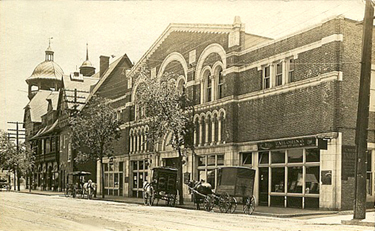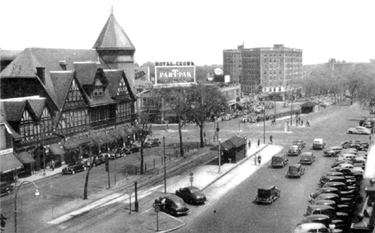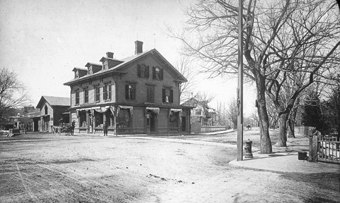Coolidge Corner is a bit mysterious to the newcomer. Where is it? What is it? Everyone talks about it, but it is not on most maps. It is not located on Coolidge Street. The biggest clue is the T stop, with its painted sign proudly naming the location. The mystery is solved when we discover the name's origins: the legacy of the Coolidge family, and the general store they built at Harvard and Beacon Street. Today the corner is easily identified by its distinctive tower, the S.S. Pierce building, which serves as a highly visible landmark. Characterized by crowded sidewalks lined with busy stores, restaurants, and the movie theater, Coolidge Corner today is bustling with activity, and is the commercial heart of Brookline. It's come a long way from its beginnings!
Creating Beacon St.Imagine a landscape of rolling hills, marshes, farms, orchards, and woodlands, and you have an idea of north Brookline in the seventeenth and eighteenth centuries. Brookline's boundary once extended to the Charles River on the north, and to Kenmore Square to the east, yet access to and from Boston was difficult. It was not until 1821, when a dam and road were built across the Back Bay, that movement between Boston and Brookline became easier, encouraging a few wealthy Boston businessmen to build summer homes in Brookline. Still dominated by large farms, the area's major landowners of the time were the Sterns, Griggs, Coolidges and Coreys, all names familiar to us now. Thirty years later, in 1851, Beacon Street was built, extending the Mill Dam Road. Initially only 50 feet wide, Beacon Street was built in conjunction with the Longwood and Cottage Farm residential developments of David Sears and Amos Lawrence. As a result of their efforts, small country estates now dotted north Brookline. As the land became subdivided and crisscrossed with roads to service these estates, the corner of Harvard and Beacon Street became a logical place to locate a general store; and, in 1857, the Coolidge and Griggs families built one. Managed by the Coolidge family until 1884, the store became a landmark, and the corner became known as Coolidge's Corner.
The End of the 19th Century Begins The Period of Rapid Growth
In 1874, Brookline gave up its Charles River frontage in order to provide a land link between the City of Boston and the newly annexed Brighton. Brookline's northern boundary became Brighton Avenue (which later was renamed Commonwealth Avenue). It was not until the late 1880's when Beacon Street was widened to 160 feet and trolley service began on Beacon and Harvard Streets, that the area experienced rapid growth and development, replacing Brookline Village as the commercial heart of Brookline. The 1890's brought the transformation of the area bounded by Pleasant Street on the east, Beacon Street to the south, and Corey Hill to the west, into streets of single family homes and apartment blocks. Many homes in this area were built and designed as part of large-scale developments, thereby endowing the neighborhoods with a consistent scale and quality of architecture, all the while accommodating a wide variety of styles. The recently proposed Graffam-McKay Local Historic District, which was built between 1895 and 1905 and includes portions of Naples, Babcock, Osborne, and Abbotsford Roads, is an example of this. At the time they were built, these neighborhoods' residents were almost all Boston businessmen.


The Second Wave
A second wave of commercial building occurred in Coolidge Corner during 1920-1930, at which time the Art Deco bank building diagonally across the street from the Pierce Building was built. The Arcade Building at 314-320 Harvard Street was built at this time as well, with its unique indoor atrium and row of bow front stores. The increased density of housing brought a greater diversity of citizens to northern Brookline. The early decades of the twentieth century saw a growing Jewish community arise along Harvard Street, and recently the Asian American population has grown. In the 1980's, improving property values triggered many homeowners in the area to renovate their properties, while respecting original architectural features. Today, Coolidge Corner continues as the vibrant, commercial hub of Brookline, and its many neighborhoods are sought after places to live.
